|
|
By Jo Nova
In the spirit of this strange moment, as Mark Steyn says:
But in Botswana everyone voted on Wednesday, the last up-country results came in on Thursday, the ruling party conceded and the new guy was sworn in on Friday.
That’s a normal election in a normal country.
Meanwhile, back in the greatest country in the history of countries, in twenty-four hours we shall be embarking on the usual folderol offour-hour lines to vote, malfunctioning machines, burst water pipes, court injunctions to keep polls open or close them down (according to taste), pausing the count before it’s completed, and the GDP-boosting quadrennial spike in plywood sales as storekeepers in DC and elsewhere board up their windows.
Meanwhile, nobody does advertising better than Americans — the pageantry, power, persuasion and fun:
It’s not about the left versus the right, it’s the people against the corruption…
10 out of 10 based on 81 ratings
9.6 out of 10 based on 14 ratings
This one’s for Peanut.
9.3 out of 10 based on 30 ratings
By Jo Nova
We need to understand the Machine
The way Mike Benz explains the world, crazy things seem to make sense, but it is at its core, a dark and deep corruption that for most us, has been operating for our whole lives. It is, though, depressingly easy to believe that people with virtually unaccountable power, even those who start with good intentions, end up at the gates of hell, discussing “heart attack guns”.
For the deep state, the dark art of influencing elections started on foreign governments, but once the CIA and State Department had honed the skills they needed, and broken every rule, what would stop them doing the same thing on domestic politics “to save democracy”? In a sense, it is as if a World War II no-holds-barred mentality has lived on to this day.
If what Mike Benz says is correct, there is no way that those who apparently influence elections all over the world will give up that power easily, especially in the most important election.
Presented Hillsdale College, transcribed at RealClearPolitics
Something has gone very wrong — that intelligence, which is supposed to serve the state, has subsumed it.
The CIA was formed in 1947 and the first election they rigged was, allegedly in Italy in 1948. Just 12 days after that election a document was written called “The Inauguration of Organized Political Warfare” by George Kennan. It was kept secret and declassified nearly 60 years later in 2005. In it, Kennan admits the government has been conducting political warfare and says they cannot leave “unmobilized our resources for covert political warfare.” They had begun three months ago “specific projects in the field” and now needed to create a covert political warfare operations directorate.
After World War II the CIA were afraid the communists were going to win in Italy. According to Benz, they spent the equivalent of $250 million US dollars (adjusted for inflation) to swing things in favor of their preferred candidate. They coopted, used, and exploited churches and charities. They beamed the US messages through Voice of America, and Radio Free Europe. They assessed that 60% of the voters would have chosen the communists if the CIA hadn’t intervened.
…they set up a vast spawn of Italian news networks to create a surround sound inside that country to broadcast U.S. propaganda and messaging. We funneled aid money through churches and charity fronts to mafia and union street muscle. We worked with Hollywood to project Greta Garbo films and others into the country.
The Voice of America and Radio free Europe were created specifically to be a tool of the CIA. Like a wartime propaganda unit but working in peacetime. The CIA battle in Italy was fundamentally dishonest. Benz claims they even went so far as to enlist the help of the mafia. They may have had noble aims, but they breached every principle the USA is supposed to stand on. It was called Political Warfare. As Benz describes it:
Miles Copeland, one of the founding members of the CIA, wrote in his own book that, “Had it not been for the mafia, the Communists would by now be in control of Italy.”
Once the CIA had tasted the fruit of election rigging, and gotten away with it, he claims they realized they needed a team in every country, just in case an inconvenient candidate looked like winning. Thus since World War II the US Empire has grown, not through conquering countries, but through “soft power”. The Italian election success lit a fire — but also crossed a line the US has not crossed since 1789.
We might wonder if Benz is exaggerating and these operatives are just running amok in Venezuela, Bolivia and Russia? Would they really be so bold as to operate in democratic Western Nations? But then, if they did start in Italy…
Today, he says, they use the exact same language and techniques to stop the rise of domestic populism on the Right.
…
The Spy agency became the Lie agency — they are paid to lie to you
Kennan, the creator of the original Political Warfare doctrine helped craft a memo NSC 10/2 that became a Presidential document that said sabotage, demolition, subversion, and propaganda was fine, as long as the government couldn’t be blamed for it. He later called it the greatest mistake he ever made:
You’ll see this memo here, NSC 10-2, and it’s right here on the State Department website, under state.gov. What I’m about to read here sanctioned U.S. intelligence to carry out a broad range of covert operations, including propaganda, economic warfare, demolition, subversion, and sabotage. It was sponsored by George Kennan. He pushed for this right after he wrote “The Inauguration of Organized Political Warfare,” but he would later say it was the greatest mistake he ever made because of the monster it created.
What NSC 10-2 did was give the intelligence community — this burgeoning, newly created CIA — and what we now have, 17 intelligence agencies plus the ODNI, not just spy organizations but lie organizations. What I mean by that is because of the phrase used in NSC 10-2, I’m going to read it:
“All of these activities, which are normally illegal, can be carried out so long as they are planned and executed so that any U.S. government responsibility for them is not evident to unauthorized persons, and if uncovered, the U.S. government can plausibly deny any responsibility for them.”
This is from 1948: “All covert operations, including sabotage, demolition, and controlling the media, are now legal as long as they are planned and executed so that any U.S. government responsibility is not evident to unauthorized persons.”
So once the CIA was legally permitted to do “illegal” activities overseas, they had to lie about it to the outside world. And thus, as night follows day, then they also had to lie to the American people. After all, they could hardly tell the American people they were rigging elections in Italy without the rest of the world finding out. Thus do small lies beget bigger lies, and pretty soon everyone forgets they’re lying for Truth, Justice and the American Way.
The people involved knew this breach was a monster, but thought they could contain it with the Smith-Mundt Act:
Wisely the intel agencies were forbidden from using political warfare propaganda at home:
In 1948, when the founding fathers of the intelligence state were setting this all up, they were intensely aware of the monster they were creating. In 1948, Congress passed the Smith-Mundt Act, because, again, in 1948, as all of this was being established, the CIA was brand new, and NSC 10-2 had just come out. Congress said, “Okay, okay, listen, you guys are creating a monster here. We want to make sure that we don’t build this empire of lies and that Americans are not being inundated with this sprawl of information control that you are conducting around the world in order to conduct organized political warfare on all countries on planet Earth.”
That was until that safeguard was repealed by Barack Obama
Even though the cheating and lies had been going on since WWII, if you have the feeling the world became extra crazy in the last ten years, perhaps there’s a reason:
Many folks in this room are probably familiar with what happened during the Obama administration, which repealed this essential safeguard, which had been with us since the moment all of this was created in 1948, with very little fanfare. It was tucked into an NDAA. It was really only discovered by the public after the damage had been done that the Smith-Mundt Act was modernized to get rid of that restriction. It was effectively amended, and the headline was, “U.S. Repeals Propaganda Ban, Spreads Government-Made News to Americans.”
For decades, this anti-propaganda law prevented the U.S. government’s mammoth broadcasting arms from delivering programming to American audiences. “Mammoth” is not a big enough word.
The American hard power of World War II evolved into American domination by soft power in peacetime:
After World War II, at this exact time in 1948, the UN Declaration for Human Rights came out and forbade the territorial acquisition of other countries by military force. Against these new international norms and standards, international law, you could not simply have a military occupation of the Philippines like the United States had in the early 1900s.
So, with hard power ruled out as the dominant means to have an empire, the U.S. transitioned to a soft power empire, dominated by agencies like the Central Intelligence Agency, democracy promotion programs at the State Department, later USAID, and the whole swarm army we’re about to meet.
After Italy, the CIA was legion, all over the world. The scope and size of this operation spread like cancer:
What happened after 1948? There is a list of CIA regime change operations after Italy. The CIA orchestrated coups in 85 countries following the Italy operation that George Kennan and other State Department officials were so inspired by. They did achieve their goal of expanding this strategy to virtually every country, continent, and region on earth and building these networks, whether they were needed or not.
Fifty of these regime change operations took place during the Eisenhower administration between 1952 and 1960.
Fifty regime changes by 1960! No wonder Eisenhower warned us about the Military Industrial Complex.
By the 1960s and 1970s the pushback to this was growing. A populist leftist faction arose to oppose the CIA. Left leaning protestors, naturally, were sympathetic to the socialist and communist countries the CIA was controlling. They saw the pain the intelligence agents were inflicting.
Mike Benz refers to the article Seymour Hersh wrote in 1974 in the New York Times exposing the CIA.
By the early 1960s, this began to come home, leading to a chain of events that caused the first real structural change to the intelligence state. During that time, the intelligence state was targeting the New Left within the Democratic Party in much the same way it is targeting the populist right today. There was a new faction within the Democratic Party, made up of not necessarily limousine liberals but anti-war protesters, civil rights activists, and supporters of third-world people’s movements. Many in the Democratic Party were socially, politically, and informationally aligned with countries targeted by the CIA.
The CIA was seen as a right-wing force because it was primarily targeting socialist and communist governments, aiming to privatize state-held industries. The agency began to do the same things against the left that they are now doing against the populist right.
Just to show how dark and malevolent this force had begun, imagine, a heart-attack gun:
Think of a democratic agency working on ways to assassinate world leaders and make it look like a heart attack. That’s not what all the CIA and FBI shows look like on TV:
 Heart Attack Gun, US CIA [32 minutes]: This is Frank Church here on the left, holding up the famous “heart attack gun,” which was in the CIA assassination guide and part of their research and development. They were assassinating world leaders, political dissidents all over the world, and were working on ever more extreme ways to kill people and get away with it, adhering to their government license for plausible deniability. The heart attack gun, which you can look up on YouTube, was discussed in an open hearing of Congress, with the director of the Central Intelligence Agency testifying. It was essentially a dart gun that induced a heart attack, making the cause of death appear natural.
On the right here is Christopher Pyle. He was one of the first whistleblowers to expose what was going on—not from the CIA, but from the U.S. Army. He provided very damning evidence that the U.S. military had active operations to survey and infiltrate any public meeting of 20 or more people in the United States, regardless of the group’s political affiliation—right, left, mothers’ knitting groups, religious groups, etc. He revealed troves of documents showing that the U.S. military perceived it was necessary to maintain political control over the civilian population to prevent any popular bills from getting passed or people from getting elected who might undermine the military agenda. This amounted to a basic usurpation of the concept of civilian-run government in a democracy.
According to Benz, the CIA had worked its way into popular culture, the media, music, even churches:
At that time, many thought leaders within the targeted section of the Democratic Party began to realize, due to these disclosures, that almost everything around them was not real—their media, culture, and music were all being used as instruments of statecraft, often directly against them. [Mike Benz lists the CIA’s use of journalists and clergy in intelligence operations.]
Very famous figures were involved in this, including many from spaces you might not expect. For example, Gloria Steinem, the famous feminist, was funded by the Congress for Cultural Freedom. At the time, our State Department was using this as a means to win the Cold War by promoting feminism to oppose patriarchal structures in countries east of Germany.
Jimmy Carter conducted the Halloween massacre, firing 30% of the CIA
I had no idea Jimmy Carter did something so useful:
Even in the 1960s, labyrinthine money laundering and hiding it from public accountability were already very robust. The Church Committee hearings popped off, and then Jimmy Carter won in 1976, coasting on popular resentment against the intelligence state. He was fiercely opposed by the intelligence state and conducted what became known as the “Halloween Massacre,” where he fired 30% of the CIA’s operations division in a single night, dramatically cutting the agency’s budget. There was this brief moment of accountability and a rollback of these plausibly deniable octopus-like operations against the American people.
After this Halloween massacre, Ronald Reagan reinstated the powers of the CIA, but the agency went underground, so to speak, keeping its visibility low.
Then Ronald Reagan came to power. In 1983, he embarked on structural changes to the way the intelligence state worked in order to restore the powers the CIA had lost during the Carter administration, including signing into law the bill that established the National Endowment for Democracy, which is now today’s premier CIA cutout. The CIA became less visible because of its previous scandals and diffused itself into a liaison role within a public-facing network of captured institutions. The intelligence state moved into the whole of society, embedding itself into cultural and media organizations, universities, NGOs, and other publicly visible sectors.
Despite all this power, the CIA is not running the world though, apparently the State Department is:
When you see the CIA or the intelligence state do something, understand that it’s to serve a State Department official, a Pentagon official, or the stakeholders around them. It’s not a rogue agency in the sense that it answers to the State Department and does the dirty work.
But what’s gone rogue is something much deeper than just the intelligence state—it’s the entrenched forces in diplomacy and defense that the CIA is tasked with serving and doing the dirty work for.
To listen to Mike Benz is to wonder if the whole world became a defacto part of The American Empire, sold as peace, truth and freedom, but based on quite a few lies and a fiat currency that is at this moment spiraling into uncontrollable debt. It was an arrangement that benefited many people in the US and abroad, but ultimately was not the American Experiment we hoped it was.
It’s easy to believe this shapes the bizarre Uniparty effect where both sides of politics end up looking so similar.
On the plus side, Mike Benz, and so many others still believe in the US Constitution. His sole goal is free speech online.
Mike Benz is Director for the Foundation for Freedom Online. He worked in the cyber section of the State Department under Trump in formulating foreign policy related to IT. He has written some speeches for Donald Trump. His aim is to preserve free speech online.
10 out of 10 based on 87 ratings
8.9 out of 10 based on 11 ratings
By Jo Nova
Four weeks before the biggest election in history, the The Wayback Machine, was hacked in a major DDOS attack. The site was restored partially, but for the moment operates as “read only”. It is not possible to ask the archive to save a page. In a strange coincidence, Google caching stopped earlier this year and officially ended in September. So there is suddenly no recognised source of common shared truth about the history of the internet at the moment. Officially, supposedly, they will be back in action, sometime, one day, and theoretically they are copying the same pages they normally copy, they just can’t update yet, or archive new pages…
Imagine how convenient that might be if someone were planning to lie, cheat, or change their story after the election?
So please, everyone, “keep a copy”, and tell your friends to keep copies too. Capture the screenshots. Save the page. Download the youtubes and save them. You never know when an election promise, a counting tally, a prediction, or a gaffe might disappear down a memory hole.
Is it just a coincidence or was this the deep state blob at work? As Jeffrey Tucker says, the timing is perfect, but we just do not know.
Deleting history helps people who want to cheat:
By Jeffrey Tucker, Brownstone Institute
Incredibly, the service Archive.org which has been around since 1994 has stopped taking images of content on all platforms. For the first time in 30 years, we have gone a long swath of time – since October 8-10 – since this service has chronicled the life of the Internet in real time.
As of this writing, we have no way to verify content that has been posted for three weeks of October leading to the days of the most contentious and consequential election of our lifetimes.
Crucially, this is not about partisanship or ideological discrimination. No websites on the Internet are being archived in ways that are available to users. In effect, the whole memory of our main information system is just a big black hole right now.
What this means is the following: Any website can post anything today and take it down tomorrow and leave no record of what they posted unless some user somewhere happened to take a screenshot. Even then there is no way to verify its authenticity. The standard approach to know who said what and when is now gone. That is to say that the whole Internet is already being censored in real time so that during these crucial weeks, when vast swaths of the public fully expect foul play, anyone in the information industry can get away with anything and not get caught.
Without the Wayback Machine Chris Gillham couldn’t have shown how the second round of adjustments in our national climate database wiped out even more historic hot days. (See the graph changes below).
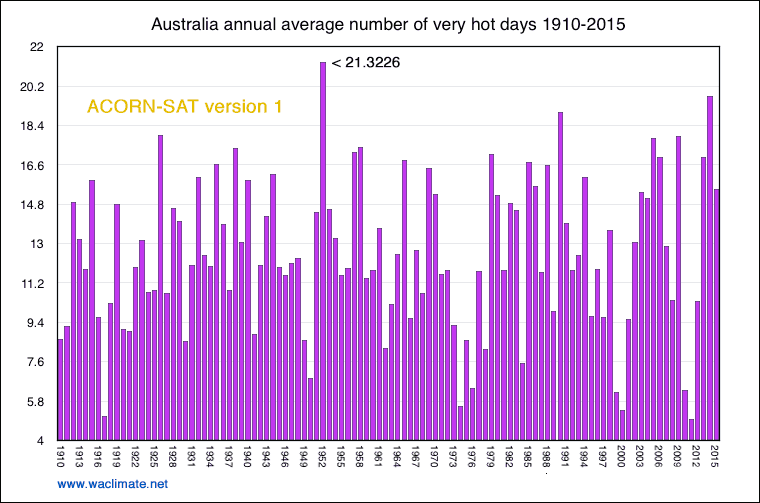 Sweeping changes in record hot days? The Bureau of Meteorology adjusted raw data to make ACORN 1 and has adjusted that further to make ACORN 2! Without the Wayback Machine we might not have a copy of the Victorian Government paper pushing for offshore wind power which accidentally admitted that all the onshore wind and solar plants they needed would require up to 70% of all agricultural land in the state.
Without the Wayback Machine we wouldn’t have a link to the original government report that listed the climate models biggest prediction and the results that showed it was a complete failure. The missing hot spot is probably the most important feedback within the climate models. All the models predicted the most rapid heating would happen 10km over the tropics, but 28 million weather balloons hunted for that signal and found it never happened. This shows water vapor doesn’t amplify the warming, and there was no catastrophe coming. After skeptics pointed out the failure, the large 6 Chapter Report from 2005 quietly disappeared. All my links to references broke, but there was a full copy on the WaybackMachine so I could update that post.
Every time government agencies screw up they want to hide the evidence. That’s why we need the Wayback Machine, and it’s why they need to shut it down.
h/t Bally, Skepticynic, and Simon Thompson.
10 out of 10 based on 92 ratings
9.3 out of 10 based on 13 ratings
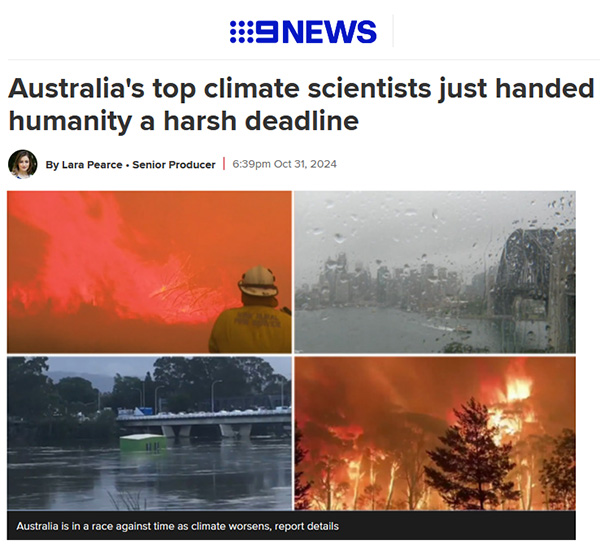
By Jo Nova
Brave scientists at the CSIRO and BoM have dug hard through the sacred Arc of the Climate Covenant, CMIP-6, to discover the horrible truth that we only have seven years (just seven!) until we pass through the sanctified Target-of-Paris on Halloween of 2031.
Channel Nine shares this “harsh deadline for humanity” and tells us the chance to limit global warming to the Paris Agreement goal of 1.5 degrees “will expire” then, like 2 for 1 sale coupon. They don’t quite explain what happens on November 1st, 2031 — but most people will assume it’s just like what happened after Prince Charles and Al Gore and the UN said we only had ten years to go (which was nothing).
But the horror show continues, not in our climate, but in our science: where the work of past scientists is deleted, and dubious datasets get adjusted with secret algorithms and thermometers near incinerators and over hot bitumen carparks that may be 1,000 kilometers away. The CSIRO-BOM Blob have massaged Australia’s temperature record so it can fit their favourite climate model. Dishonestly, both institutions hide the heat of the Federation Drought, where places all across Australia recorded temperatures over 50 degrees in 1896. BoM and CSIRO delete the cooling trend their own experts recorded from 1900 to 1950 in Australia. (Deacon et al).
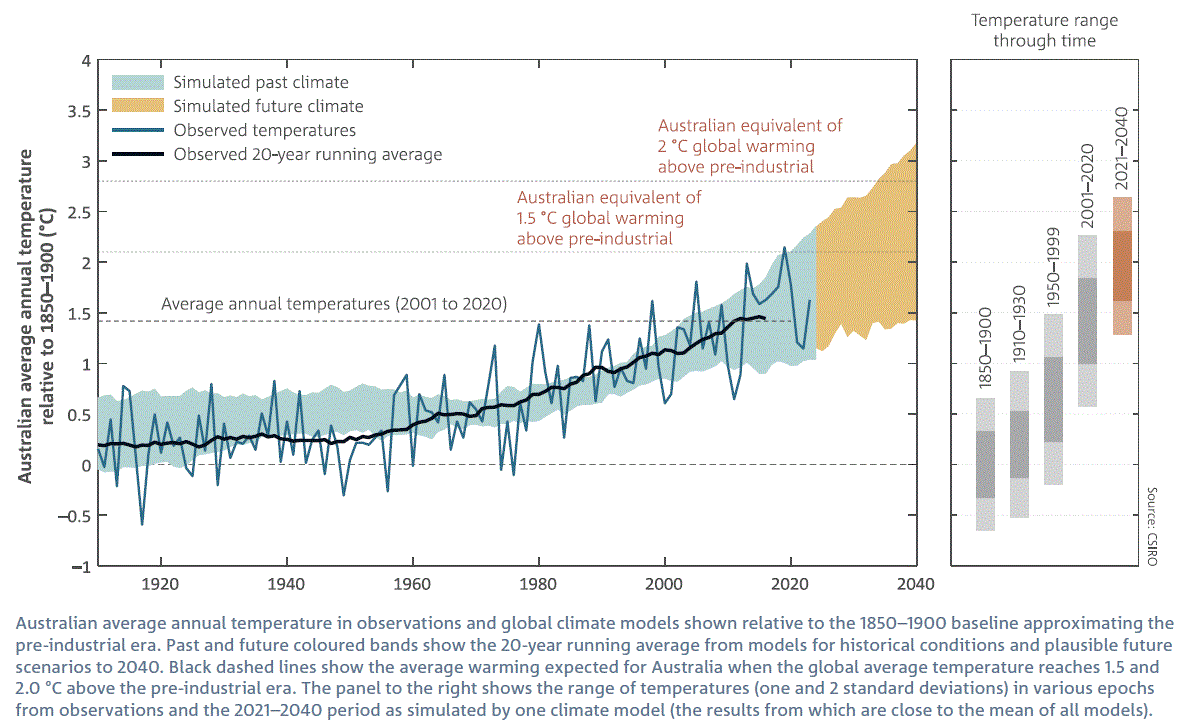 A carefully curated curve. BOM CSIRO State of the Climate 2024.
The BOM and CSIRO pretend the temperatures are accurate in the graph above. They don’t tell Australians that they keep adjusting the data, even a hundred years after it happened. Some poor towns didn’t know they were two degrees colder in World War I until the BoM “discovered” that in 2014. The people of Marble Bar thought they had the hottest heatwave in world history in 1923 until the BOM traveled back in time to delete it, I mean “correct it”. Temperatures in 1910 have fallen 22 degrees Fahrenheit in the last 10 years.
At the current rate of decline, the 1920 miners of Marble Bar will be in an ice age by the end of the century.
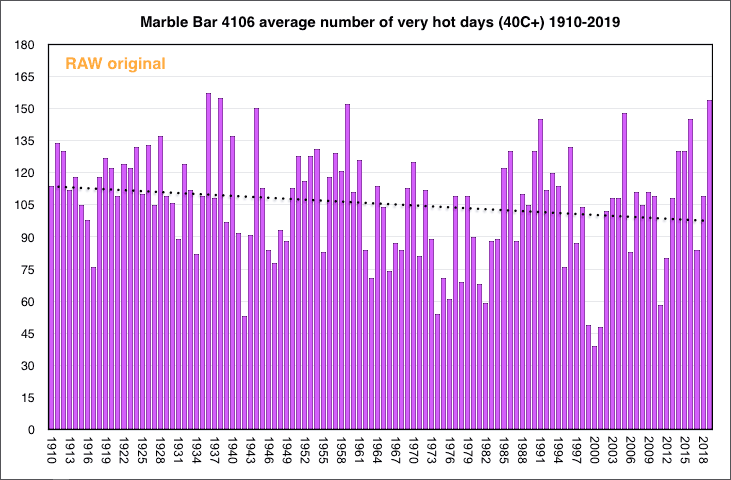 marble bar very hot day trends The irony is that the BOM ignore the hot temperatures of the 1800’s because they were not in standardized modern Stevenson screens, yet the BOM is happy to take those lauded Stevenson screen measurements from 1920 and drop them in a high speed homogenization-blender to adjust them by as much as 2 degrees.
So the BOM can “adjust” the data to get any trend they want. Then there’s the added heat of a million tons of concrete and brick keeping our cities warm. And on top of that scientific hamburger, thermometers boxes shrank from 230 litres to 60 litres, and glass instruments became electronic ones. They don’t mention that their super accurate new gizmos can pick up brief changes in temperature that the old glass ones can’t. And possibly they can pick up the airport radars too.
Maximum record temperatures may be a one-second-record, literally there and gone in a moment, and if it was radar interference, not even there at all.
When asked, the BOM say they have calibrated and tested the different thermometers side by side, to show they are comparable, but they won’t release the data. As if the thermometer readings at Canberra airport are a national security issue.
They also don’t mention that scientists in Australia were reporting that Australia was cooling from the 1890s to 1952. (Deacon et al) The ghastly heat of 1896, the Federation Drought, and the 50C record temperatures all over Australia all go down the memory hole.
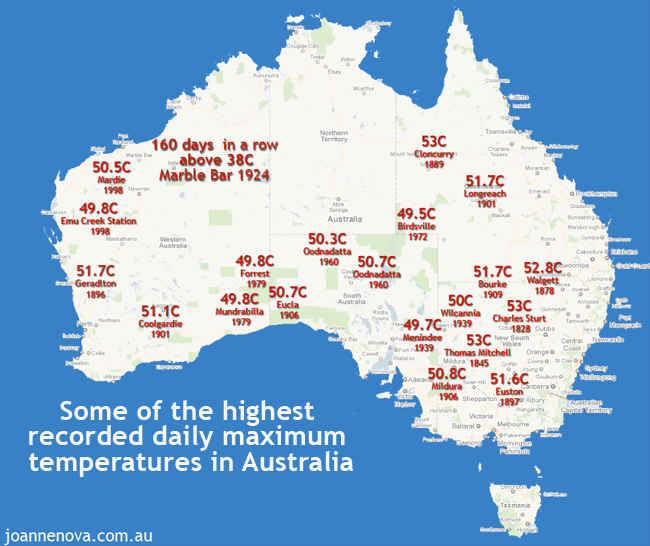 Historic heatwaves. 50 degree temperatures were everywhere, right across Australia in the 1800s and 1900s.| Not surprisingly, after we adjust all the records, we find extreme heat events are increasing
And this is the shocking graph the BOM-CSIRO blob gave us in 2024:

But ten years ago the BOM showed Australians a different graph, one which looked like this, til they took it off their own website. And there is bound to be some excuse to justify it. A different permutation or combination of variables, an older dataset, some plausible deniability.
But the fact remains, that the BOM-CSIRO-blob are not trying to give Australians the whole truth and nothing but the truth:
 Number of very hot days in Australia up to 2016. It was on the BOM site… Reading the tea-leaves on rain in Australia
By selecting some contrived permutation the BOM-CSIRO-Blob can create the illusion that something unusual is happening. Here, they show the April to October rainfall in one particular part of the country as if this has some special meaning. (Their climate models fail on rainfall trends nearly universally). The Blob can cherry pick permutations until they find something. But here, even the best trend they can get doesn’t resemble our CO2 emissions. Why was the winter rain almost as low in 1940? The BOM don’t know. They could make up some reason post hoc, but they can’t predict it.
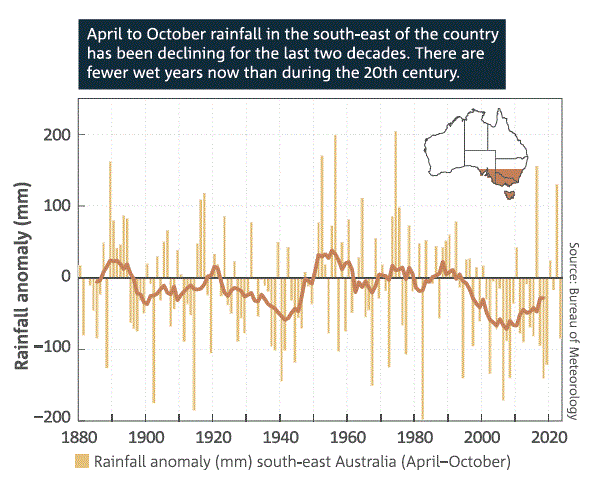 Rainfall decline in SE Australia. BOM CSIRO State of the Climate 2024. If the BOM-CSIRO-blob wanted, they could show Sydney-siders the total rainfall record for the last 130 years. But they can’t because it would be obvious to everyone that it has nothing to do with CO2. It could just be noise in the system, oceanic oscillation, or cycles controlled by the sun.
This (below) was the total rainfall in Sydney from 1840 to 2019, and the total number of rainy days, the peak amount of rain that falls in a single day and the intensity of the downpours. Why isn’t it in the State of the Climate? Why haven’t the BOM updated this graph? (From the Ashcroft paper of 2019).
 Rainfall trends, cycles, Australia, Sydney, Graph, 2019, 1840 – 2020..| Abbreviations: Rainday counts (RD), monthly rainfall totals (Rtot), and highest daily rainfall (Rx1day). The Simple Daily Intensity Index (SDII): the amount of rainfall received divided by the number of raindays recorded over a month and year. The exact same pattern is visible, by the way, in rainfall records from Melbourne and Adelaide too. But almost no one in Australia would know that. The ignorance isn’t an accident.
Thank the BOM. Thank the CSIRO. Thank the ABC.
REFERENCES
LindenAshcroftabDavid J.KarolyacAndrew J.Dowdyb(2019) Historical extreme rainfall events in southeastern Australia, Weather and Climate Extremes Available online 10 May 2019, 100210
Deacon, E.L. (1952) Climatic Change in Australia since 1880, Australian Journal of Physics, Volume 6, Pages 209-218. [PDF]
State of The Climate 2024 can be found on the CSIRO and Bureau of Meteorology websites.
State of the Climate 2022, Bureau of Meteorology
State of the Climate 2022, CSIRO
State of the Climate Report CSIRO 2014. CSIRO
Previous State of the Climate Reports, CSIRO
And even more droughts and trends graphs here.
9.9 out of 10 based on 101 ratings
9.3 out of 10 based on 19 ratings
9 out of 10 based on 21 ratings
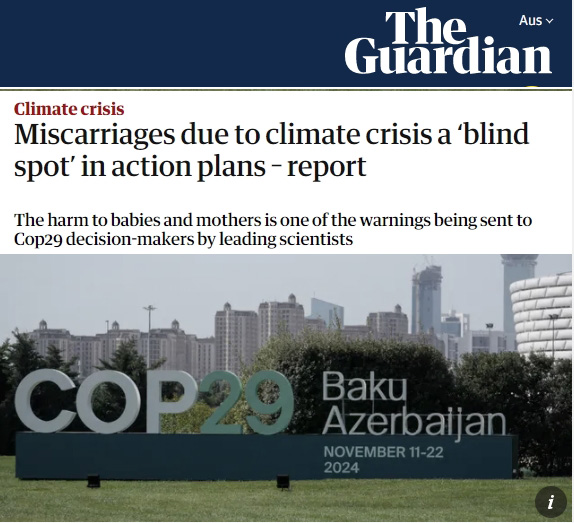
By Jo Nova
This week’s UN witchcraft is that a half a degree of global warming will kill babies and pregnant women, give us your money.
The UN COP29 meeting starting Nov 11th, fights for relevance in the shadow of the US Election, like a suckerfish under an aircraft carrier.
The latest confected attempt to get attention is to guilt trip the West — telling us that women and babies will die if we don’t install enough solar panels. This is despite humans being mammals which evolved to cope with the heat and the cold. We live a more closeted, protected existence than any time in the last million years. Not many people give birth in caves these days. Indeed we’re a species that inhabits towns with monthly temperatures that vary by 90 degrees Celsius and we are supposed to panic about another half a degree?
The truth is that being cold, poor and hungry increases stillbirths just as much as any heatwave, and the thing that saves babies on a hot day is an air-conditioner. The answer to all four killers thus, is cheap electricity and fossil fuels.
One day history students will study how the UN uses biblical paraphrasing to demand their tithe and control:
The report follows an ultimatum from the UN secretary general, António Guterres, on the climate emergency: “We’re playing with fire, but there can be no more playing for time. We’re out of time.” He said global heating was supercharging monster hurricanes, bringing biblical floods and turning forests into tinderboxes, and said governments had to rapidly wean the world off its fossil fuel addiction.
Naturally, only babies that die from heat stress are politically marketable, the UN doesn’t care about the ones that die from the cold:
Increasing climate extremes are causing more lost babies, premature births and cognitive damage to newborns, the report said. For example, a study in India found a doubled risk of miscarriage in pregnant women suffering heat stress, while another in California found a significant association between long-term heat exposure and stillbirth and premature birth.
Awkwardly, cold temperatures also cause stillbirths and miscarriages (Ruan et al) so if man-made climate change is warming the world, it must be saving babies too. Shh!
Five minutes of research, which the Guardian team don’t do, turns up a meta-study showing that poverty doubles the risk of death in babies:
Numerous studies confirm that mothers of low socioeconomic status and unemployed parents face a far higher risk of having a stillbirth or a low birthweight child [7–10]. It has been demonstrated that women or families living in adverse socioeconomic conditions have twice the risk of having a stillborn baby compared to their more privileged counterparts [11]. Unemployment and unfavourable economic conditions are usually associated with poor maternal nutrition, elevated psychological stress during pregnancy and limited access to medical supervision and prenatal care. Several studies show that pregnant women with elevated levels of stress have considerably higher risks of a stillbirth, independent of age, parity, education, smoking and alcohol habits or other compromising characteristics…. Moreover, in low income countries or deprived environments, poor maternal nutrition and low body mass index can result in higher stillbirth frequency [15]. — Tsimbos et al (2021)
Thus to save babies, and follow the science — we must burn more fossil fuels
Wealthier nations have higher CO2 emissions, more heaters, more air conditioners, better food, and their babies don’t die as often.
It is a crime the UN is not helping poor African nations build coal plants.
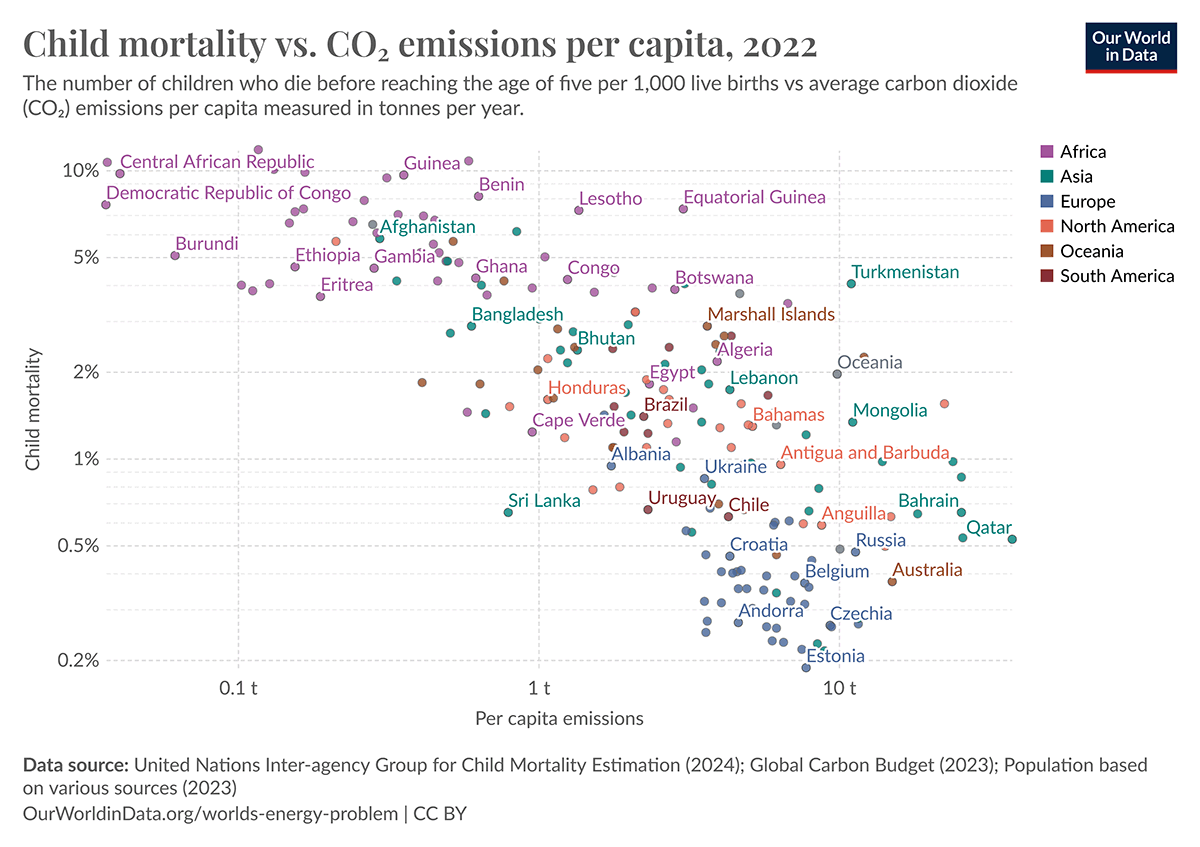 Child Mortality falls as CO2 emissions rise per capita. | OWID UPDATE#2: TonyfromOz asked where China was, and pointed out that it and many big countries were missing which is a great point. So here below are the top 25 largest in population plus a few other notables.
As expected, the largest countries almost all fall in the centre of the trendline.
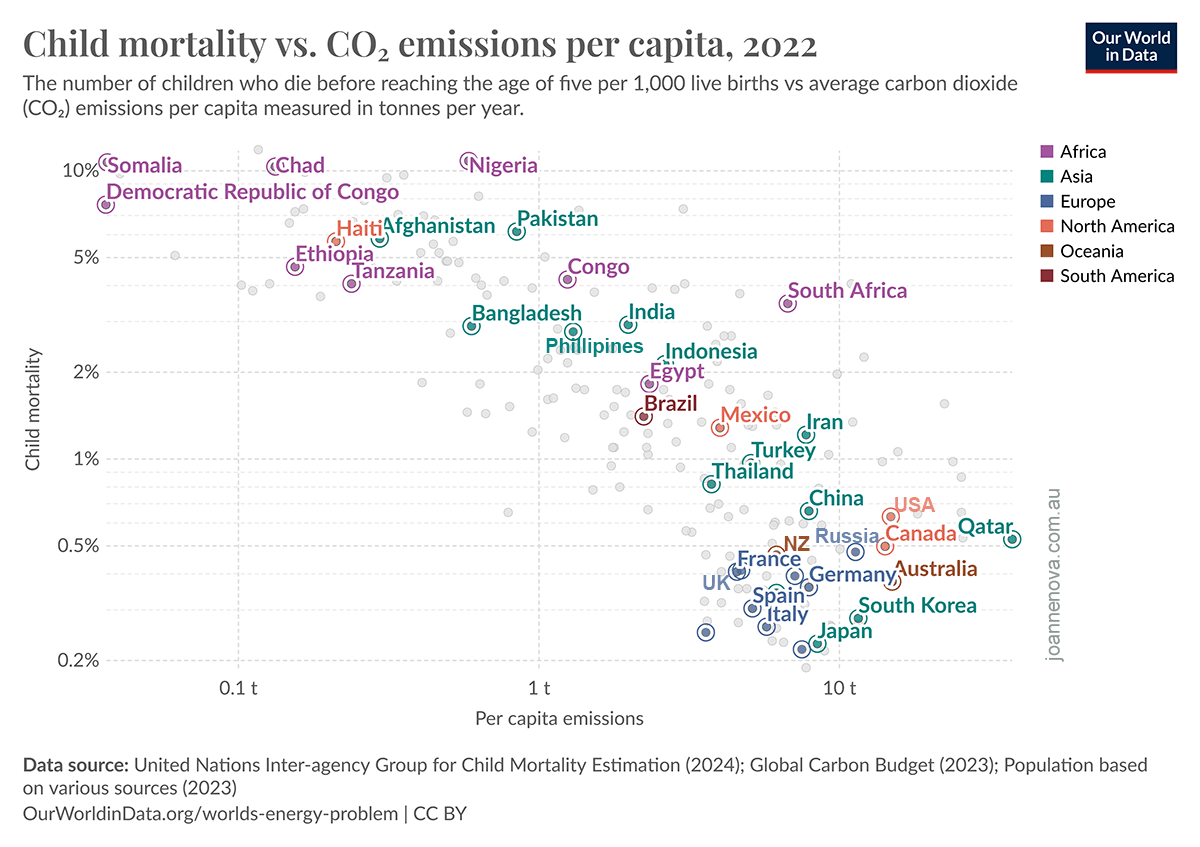 Child Mortality, CO2 emissions. OWID https://ourworldindata.org/grapher/child-mortality-vs-co2-emissions-per-capita
REFERENCES
Cleon Tsimbos, Georgia Verropoulou Dimitra Petropoulou (2021) Economic crisis and stillbirth ratios: Evidence from Southern Europe, PLoS One, 2021 Nov 18;16(11):e0259623. doi: 10.1371/journal.pone.0259623
Ruan T, Yue Y, Lu W, Zhou R, Xiong T, Jiang Y, Ying J, Tang J, Shi J, Wang H, Xiao G, Li J, Qu Y, Mu D. Association between low ambient temperature during pregnancy and adverse birth outcomes: A systematic review and meta-analysis. Chin Med J 2023;136:2307–2315. doi: 10.1097/CM9.0000000000002361
9.9 out of 10 based on 82 ratings
10 out of 10 based on 11 ratings
By Jo Nova
Spare a thought for the people of Cuba
The situation went from awful to something much worse.
They ran out of working electrical plants ten days ago, and endured blackouts lasting for four straight days, including one hurricane. Reports coming out suggest that though electricity is partly restored, it’s often only for four hours a day. Not surprisingly, the country is semi-paralyzed — schools are still closed and “labor services” are largely non-existent, apart from hospitals, funerals and efforts to repair the damage caused by Hurricane Oscar.
Soon they may run out of people. People were fleeing Cuba before things got this bad.
The big blackout began on Friday October 18th. In the next four days they restarted the grid three or four times only to have it crash again, and while power is sort of mostly restored the structural problems appear to be dire. Nothing really sums the state of the communist economy better than one line on Vox news which described the moment the big blackout began:
“Seven of the country’s eight thermoelectric plants, which generate power for the island, were not working or under maintenance prior to the Guiteras plant’s failure. So when the Guiteras plant shut down, there were no more energy sources.”
As if “seven out of eight” is not bad enough, there’s more. Cuba can’t get subsidized fuel anymore from Russia, Mexico or Venezuela, and they can’t afford to buy fuel at market prices. The economy is kaput. They don’t make many things that the world wants to buy, and tourism dried up with the pandemic.
It appears that either the only surviving plant suffered a malfunction, or the nation actually ran out of fuel, or both. Reuters is somewhat vague:
Reuters
Long-time ally Venezuela slashed fuel shipments to Cuba by half this year as it struggles to assure supply at home. Allies Russia and Mexico have also cut exports to Cuba, forcing the cash-strapped government to seek far pricer fuel on the spot market.
The situation came to a head on Friday, when Cuba’s largest power plant malfunctioned, joining several smaller plants already offline. Foul weather had also stalled the arrival of fuel from tanker ships offshore, starving the island’s power plants. The combination prompted the entire grid to collapse.
Life is tough. Generators were only able to power hospitals for emergency situations.

People are collecting wood in the streets so they can cook anything for dinner. Even before the blackout some 600,000 had no running water, and now that is worse. The BBC reports that some are now going hungry.
Predictably there are fears the exodus will grow
The word is that the government won’t let people protest the dire living conditions, but it will let them leave, so one million people have left in the last three years. (There go the dissidents, the ambitious, the motivated, and often the brightest). Since Cuba had a population of around ten million, effectively ten percent of the country left since 2021.
There are fears this will only increase:
This crisis could fuel a further exodus; an estimated 1 million Cubans have left the country in the past three years, the largest such migration in the country’s history. One Havana-based economist, Omar Everleny, told the New York Times he’s already starting to see a new wave of emigration: “Anyone who was thinking of leaving is now accelerating those plans. Now you’re hearing ‘I am going to sell my house and go.’”
By Martin Gurri, The Free Press
This is not an exaggeration or a metaphor. The entire island went dark—even Havana, which has been protected from the worst of the recent blackouts. It was a civilizational breakdown. The economy quite literally ground to a halt, as factories and stores were ordered closed by the government. From elementary schools to universities, the educational system was put on pause. Hospitals turned people away. For three days, Cuba, already tattered and abused, entered a special circle of hell reserved for the most mismanaged nations on earth.
The material catastrophe is self-evident and can be measured empirically. The depth of human suffering is impossible to gauge from a distance. Without refrigeration, food—always hard to obtain—was spoiled. Mothers lacked milk for their children. Without fans or air conditioners, everyone, including the very young and the very old, was exposed to Cuba’s blistering temperatures. Without elevators, the old and the sick who lived in apartments were forced to sleep outdoors, in the heat and among the mosquitoes. Without traffic signals, venturing to the streets became a death-defying nightmare. Without light, the human mind itself begins to shut down—the Cuban public, frozen in place by an incompetent and antiquated regime, sank to almost metaphysical levels of hopelessness.
Bad governments can ruin a lot of lives:
People are angry. Online many people complain that the government built many fancy hotels for tourists, instead of fixing the electricity grid for the people.
Despite the crisis and the hurricane, Cuba’s President Miguel Díaz-Canel somehow found the time to advise the citizens that “if they protest on the street they will be prosecuted”. He put on military garb and said the protestors were just drunks, as if sober people would not mind having no functional economy.
 … It’s hard to get stories out of Cuba but ex-pats or friends outside Cuba post opinions on Reddit and they are gloomy.

The problems in the Cuban grid have been decades in the making.
The eight power plants are largely crude fuel oil plants of about 400MW. In total, theoretically, they could generate 2,500MW. In actuality, they are badly built, badly maintained, and 30 to 40 years old. Power generation has declined by 25% in the last five years.
Ruaridh Nicoll in Havana, The Guardian
“It’s very hard to restart a power station,” said a retired engineer from Antonio Guiteras, who asked to remain anonymous. “You need to produce a lot of electricity just to get it going.”
Antonio Guiteras was built in 1989, and is now battered and obsolete. “The truth is that it was built rotten,” said the engineer. He told harrowing stories of working with faulty safety equipment, political management who would disappear when problems arose and a system long pushed to its limit.
“There was a scheduled maintenance programme, but it was never followed,” he said. “The requirements were too tight. We were told: ‘The factory has to produce, so patch it up.’”
Somehow, despite Cuba being almost a failed state, there are glorious plans to build 26 solar farms with a capacity of one gigawatt. As the Guardian tells it, China has offered the parts to make them, in return for access to Cuba’s nickel deposit. Though there are fears that the people who might have been able to build the solar plants have already left Cuba. What then?
The gigawatt of solar (if it even happens) will only provide about one third of existing demand at most, and will obviously only work in the middle of the day, and possibly not at all after the first hurricane. As Broken Hill, and Alice Springs know, when things are desperate, solar panels are not the answer. Baseload comes first.
If Cuba can’t get fuel oil, and get the grid functioning, surely food and water will run out, and people will be forced to make some very tough decisions.
If the grid can’t supply enough energy for the people, in the capitalist world the answer is “more grid” but in the communist world, it apparently means “less people”. In this case Cubans are “lucky” enough to be allowed (at the moment) to walk or swim away, but for how long?
h/t Chad and another ian.
h/t Tony Thomas one mega corrected to giga…
10 out of 10 based on 77 ratings
9.3 out of 10 based on 15 ratings
By Jo Nova
The lights went out in Broken Hill. A storm blew seven transmission towers over disconnecting the area from the national grid on October 17th. About 19,000 people live there, and with a 200MW wind plant, a 53MW solar array and a big battery, plus diesel generators it was assumed they’d be OK for a while without the connection to the big baseload plants, but instead it’s been a debacle. They’ve had nearly a week of blackouts with intermittent bursts of power, barely long enough to charge the phone.
The fridges in the pharmacies failed, so all medications had to be destroyed and emergency replacements sent in. Schools have been closed. Freezers of meat are long gone… Emergency trucks are bringing in food finally and hopefully the schools will reopen today. But the full reconnection will not happen until November 6th.
By Joanna Panagopououlos and Alexi Demetriadi, The Australian
Mayor Tom Kennedy said state and federal governments “needed to learn” from the experience, and how wind and solar energy are “almost useless” in a crisis without baseload power.
“(Wind and solar) are worse than useless (in a crisis like this), because it’s detrimental to having a consistent power supply,” he said. “I’d hate to see what happens in the capital cities in a similar crisis.”
The bad news is that when there is no reliable 50Hz baseload supplier of electricity, the solar panel inverters just don’t mesh well with the diesel generators. The frequency of the diesel generators varies slightly as the load changes, and these fluctuations cause issues with solar inverters, which need a stable frequency to synchronize properly.
Hence, in a blackout, the solar panels were not just useless, they were a threat to the system, so people were asked to switch them off:
Essential Energy on Friday was urging customers in Broken Hill to switch off their solar supply main switch to protect the 40-year-old backup gas-turbine generator providing power to the town and surrounds.
From within Broken Hill, a forlorn Jack Marx is dotting out his story in The Australian via his phone:
…Broken Hill, has been in blackout for five days.
The power comes on from time to time, but goes out just as quickly. It gives us just enough time to power our phones and read emails from energy providers sent the day before, alerting us to the fact the power was about to go out. They also warn we don’t have much time, and to avoid using unnecessary electrical devices – air conditioners, fridges or fans that need a power point.
The unreliable generators survived the storm but were still useless. Giles Parkinson suspects (fervently hopes) that this is just a bureaucratic issue, rather than a technical one:
Giles Parkinson, RenewEconomy
The fact that the wind farm and the solar farm aren’t operating with the transmission line is understandable. But the big battery is supposed to be – and that could in turn have allowed the wind and solar to produce. No one is saying what’s gone wrong, but many suspect it’s a matter of oversight rather than technology.
“You need to talk to Transgrid,” said one. “You should talk to Essential,” says another. “Ah, that’s AGL’s asset, you better talk to them.” And then. “No, Tilt Renewables own those. Give them a ring.” And finally, “we don’t have an official statement now, but we are trying to sort it.”
It certainly was mismanaged. But that’s just it, isn’t it? A decentralized grid has a million moving parts, and thousand agencies that can all screw up together. Complexity has a cost. But it’s not just mismanagement,a wind and solar system is not just expensive, but lacks inherent stability. Sure, eventually, if we hock the nation we can find a way, but why? To make storms nicer in a hundred years?
Solar power is not just superfluous, it’s toxic
The big Broken Hill battery finally restarted on Saturday to help the town cope with the evening peaks in demand for electricity. But the intrinsic problem remains in these remote communities, erratic solar power doesn’t work well with diesel gens, and everything needs to be fully backed up in any case. As we saw in Alice Springs, it didn’t take much solar power, for one big cloud to cause a blackout. The Northern Territory was so scarred by that blackout in 2019, they’ve left 4 solar plants sitting there idle ever since, in fear they’ll crash the Darwin-Katherine grid.
So much money and so little to show for it:
Even with a price tag, our renewables future is already broken
Nick Cater, The Australian
The Silverton Wind Farm and Broken Hill Solar plant were supposed to produce enough electricity to power 117,000 homes. They’re supported by AGL’s 50MWh battery facility at Pinnacles Place, one of the largest in Australia. Yet Broken Hill, population 19,000, has been in a semi-permanent state of blackout since a storm brought down the transmission line connecting the town to the east coast grid.
Some $650m worth of renewable energy investment within a 25km radius of Broken Hill has proved to be dysfunctional. The technical challenges of operating a grid on renewable energy alone appear insurmountable using the current technology.
Instead of spending $650 million dollars on solar and wind and a battery, we could have bought two brand new useful diesel generators for every remote town in Australia, and then when transmission towers fall down, they won’t be left in the dark.
9.9 out of 10 based on 123 ratings
8.8 out of 10 based on 16 ratings
8.9 out of 10 based on 20 ratings
The millionth comment came in this afternoon (on the Friday thread). Congratulations to Simon Thompson M.B. B.S. for the millionth comment. With Yarpos at 999,999 and Old Ozzie at one million and one.
For the record, I’ve emailed all three and offered to post them a set of books, with thanks.
Of course, this really is an achievement of all the commenters who share their thoughts and expertise on a world of absurdities, and thanks to the tireless moderators who made it possible.
And thinking of those great minds who shared so much and are no longer with us…
— Jo
9.8 out of 10 based on 102 ratings
 The World Bank — Who We Are. As they say — we’re “Accountable to ourselves”. By Jo Nova
The World Bank is the largest climate funding multinational blob on Earth, and the world is about to end, the oceans are about to boil, but no one at the World Bank can explain where billions of dollars worth of the Earth saving funds have ended up. It’s almost as if no one there gives a toss about the climate. Indeed, if the World Bank was a giant parasitic squid feeding off the taxpayers of the West, it might look just like this.
A new Oxfam report shows that over six years, $24,000 million dollars (at least) has probably gone missing off the balance sheets, but it could be as much as $41 billion. Essentially, the World Bank budgeted to spend a lot of money, but no one bothered to track whether that money was spent, whether the budget blew out, or whether it never happened and the team went surfing in Costa Rica. Imagine if we could do our taxes this way? Indeed, it’s a bit rich to say the money was “missing off balance sheets” because apparently there weren’t any balance sheets, not for expenditures.
Oxfam can only guess at the missing sums because they investigated other World Bank projects and found the final cost differed from the planned cost by between 26 to 43%. So they used that to come up with a ballpark figure of the size of the missing millions. It’s that bad. We can’t even say how much is missing. One insider told the New York Post, “it could be twice or ten times more”.
The supranational unaccountable entities like the World Bank, the UN, are surely the great attractor of global freeloaders. Like a supermagnet for people who like spending other people’s money:
By James Franey, New York Post
What if it wasn’t bungling — who would know?
Bungling World Bank bureaucrats lost track of at least $24 billion bankrolling the battle against climate change, according to a bombshell report by a left-leaning charity group.
An investigation by Oxfam revealed “poor record-keeping practices” by the DC-based international lender that resulted in anywhere between $24 billion and $41 billion in misplaced funds.
The agency’s audit showed “a lack of traceable spending” over the past seven years — partly because of an oddball accounting practice in which the bank accounts for its climate financing at the time of a project’s approval rather than at the time of project completion,…
In the report: Climate Finance Unchecked Oxfam discovered that it was extremely difficult to get simple answers:
“We had to sift through layers of complex and incomplete reports, and even then, the data was full of gaps and inconsistencies. The fact that this information is so hard to access and understand is alarming —it shouldn’t take a team of professional researchers to figure out how billions of dollars meant for climate action are being spent.
This could all be sorted out in five minutes. All it would take is for our governments to say “No more money for the World Bank until it sorts out reporting”, and next thing you know the World Bank would be filling out tax returns. But the odds of this happening are like an asteroid strike — unless Donald Trump wins the US election (above the margin of cheating). Mere mortal politicians who ask hard questions, not only risk their post-political Blob career with the UN-WEF-World-Bank-IMF-FAO-WHO-IAEA-or-OECD, they might feel the force of a World Bank report telling their citizens how they mismanaged their own economy, and who wants that?
The amounts of money are mind-blowing
The Oxfam writers, bless them, are slightly baffled. With the world in dire straits (as they see it) they can’t figure out why the World Bank is not treating every dollar like a diamond.
…the sums needed are vast and growing: According to the UN’s Adaptation Gap Report 2023, the amount needed for
adaptation finance alone stands at between US$215 billion and US$387 billion a year.
There is so much potential. If the World Bank got what it asked for, and spent 90% in an honest way, there would still be $30 billion dollars left to throw parties. But if no one is tracking any of it, why not think big?
“This is the wild, wild west of finance,” said Mark Joven, Philippines Department of Finance undersecretary, who represents the country at U.N. climate talks. “Essentially, whatever they call climate finance is climate finance.”
“You cannot really follow the money, track the money, track the impact,” said Romain Weikmans, a senior research fellow specializing in climate finance at the Finnish Institute of International Affairs.
–“Rich nations say they’re spending billions to fight climate change. Some money is going to strange places.” Reuters.
Big Government feeds Bigger Government
The Globalist Blob not just The Promised Land for political grifters, on a practical basis, the more they can siphon from the people towards the blob — the more friends they make in the international blob-glitterati, and the better chance they have of being offered the next great blob job offer.
Medium level domestic bureaucrats are surely looking to the land of milk and honey, which is where taxpayer funds escape the event horizon of audits and elections. Only there, can the parasites do whatever they want with other people’s money.
Download Oxfam’s new report “Climate Finance Unchecked.”
9.9 out of 10 based on 108 ratings
Comments standing at 999,872
At 1:12AM Queensland time Friday.
UPDATE: Congratulations to Simon Thompson M.B. B.S. for the millionth comment. With Yarpos at 999,999 and Old Ozzie at one million and one. 19.2
9.1 out of 10 based on 21 ratings
|
JoNova A science presenter, writer, speaker & former TV host; author of The Skeptic's Handbook (over 200,000 copies distributed & available in 15 languages).

Jo appreciates your support to help her keep doing what she does. This blog is funded by donations. Thanks!


 Follow Jo's Tweets
Follow Jo's Tweets To report "lost" comments or defamatory and offensive remarks, email the moderators at: support.jonova AT proton.me
Statistics
The nerds have the numbers on precious metals investments on the ASX
|
















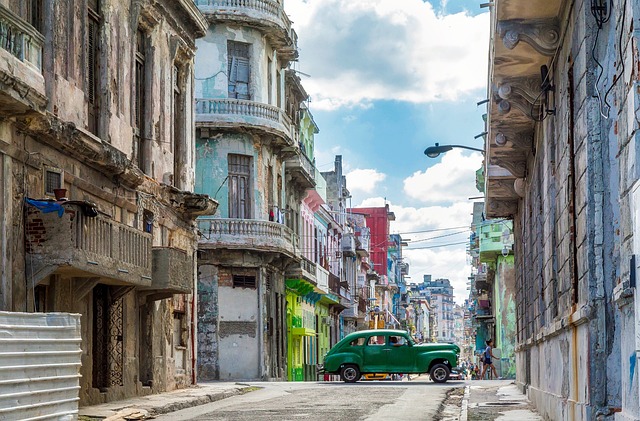




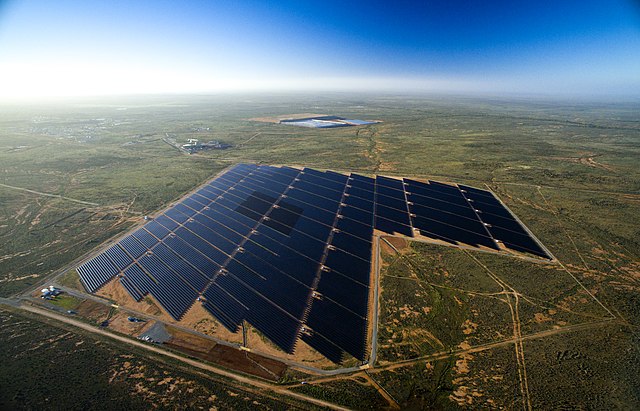
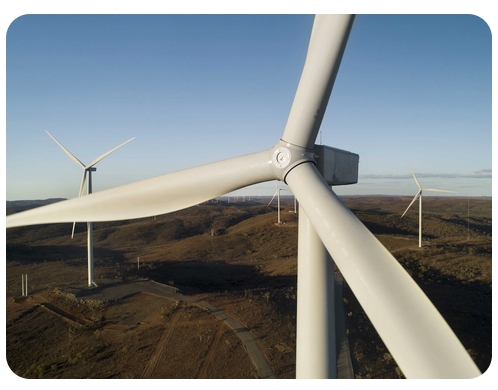













Recent Comments